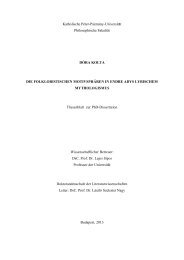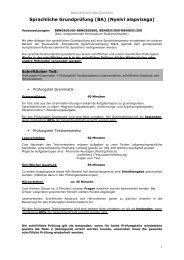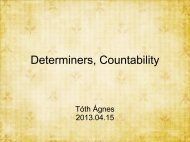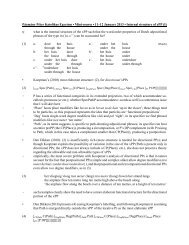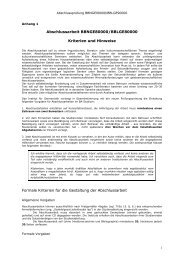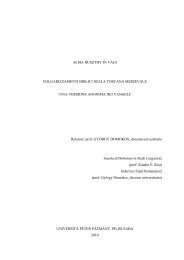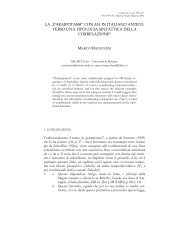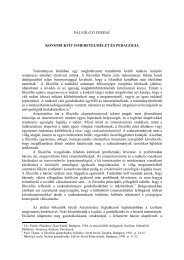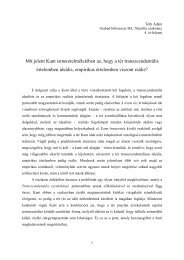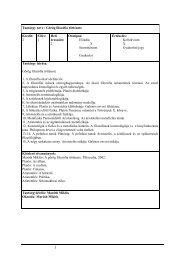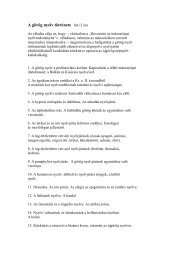“Ambisyllabicity” across word boundaries:
“Ambisyllabicity” across word boundaries:
“Ambisyllabicity” across word boundaries:
You also want an ePaper? Increase the reach of your titles
YUMPU automatically turns print PDFs into web optimized ePapers that Google loves.
well as what the t’s in atom and at issue share. The starting point that I will take draws on<br />
Rubach (1996), who observes that several connected speech phenomena can be accounted for<br />
more insightfully with reference to ambisyllabicity rather than resyllabification. In Section 1 I<br />
present his examples from RP, and show how GA t-tapping fits into the picture. Then I go on<br />
to introduce the theoretical devices I will make use of, viz. Strict CV Phonology equipped<br />
with Lowenstamm’s (to appear) boundary marker as well as certain aspects of Szigetvári’s<br />
(1999) Coda Mirror Plus (Section 2). I will base my analysis of connected speech phenomena<br />
on government and licensing as defined in Dienes & Szigetvári (1999) and Szigetvári (1999)<br />
with a few modifications (Section 3). I will suggest that licensing and government should be<br />
restricted to the CV-tier and the segmental level/nuclear projection, respectively, and that the<br />
stressedness or stresslessness of vowels is not reflected in their ability to govern but the order<br />
of preference whereby they choose the way in which they affect adjacent segments. I will also<br />
assume a complementary relationship between government and licensing.<br />
1 Ambisyllabicity rules in English<br />
Rubach (1996) refers to Kahn’s (1976) study of GA, claiming that flapping affects<br />
ambisyllabic t’s, and adds further data from RP (ibid: 220), which also support that<br />
ambisyllabicity rather than resyllabification applies <strong>across</strong> <strong>word</strong> <strong>boundaries</strong> in English (see<br />
(1) 1 ).<br />
(1) RP r-tapping<br />
a. []: courage, very, sorry, baron, laurel<br />
b. [r]: courageous, reduce, red, bright, Henry, walrus<br />
c. []: for example, for instance, the other end<br />
Notice that if <strong>word</strong>-final r’s are resyllabified into the following vowel-initial <strong>word</strong>,<br />
then they get into onset position and are expected to exhibit the approximant allophone, as in<br />
(1b), and definitely not the tap. However, what we observe is the opposite (cf. (1c)), which<br />
leads us to suppose that the r’s appear in the same environment in (1a) and (c). Note also that<br />
while in (1a-b) the place of stress does make a difference (compare cóurage and courágeous),<br />
in (1c) we get the same allophone irrespective of whether the capturing vowel is stressed (as<br />
in for ínstance) or not (for exámple). All these observations must evoke a feeling of déjà vu<br />
because of the discussion of flapping above, exemplified in (2) below.<br />
(2) English (Kahn 1976 and Kaisse 1985) 2<br />
a. á[]om a[t h ]ómic<br />
b. hi[] Ánn hi[] Aníta hi[ t] me<br />
c. grow [t h ]omátoes<br />
d. wai[] a mínute<br />
e. a [t h ]íssue a[] íssue<br />
In (3) an additional set of data is found concerning another phenomenon in RP, l-<br />
darkening (also described in e.g. Rubach 1996).<br />
1 The same data are described in Jones (1960), and Wells (1992: 282) as “a useful diagnostic” of U(pper-crust)<br />
RP as opposed to mainstream RP.<br />
2 As pointed out by the anonymous reviewer, GA t-flapping has a few additional conditions so that it is possible<br />
in certain consonant clusters (e.g. in party, shanty) but not in others (*actor, *mister, *(?)Bolton, *mattress).<br />
Since the present discussion concentrates on flapping in intervocalic position, these data will be ignored.



